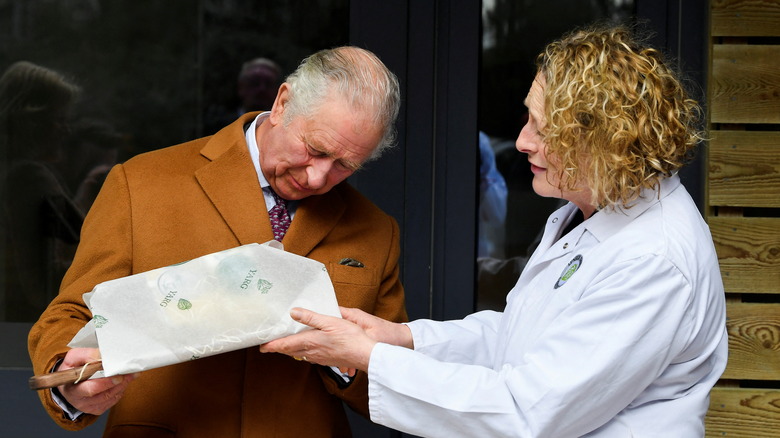Cornish Yarg: The British Cheese Aged In Stinging Nettles
Cheesemaking in England has a very long history. According to English Heritage, ancient Britons were processing dairy as far back as 3800 B.C. Later, the Romans introduced sophisticated cheesemaking techniques and large-scale sheep farming to the British Isles. During the Middle Ages, British monks continued to refine the art of cheesemaking, influenced by French monks who exchanged techniques through international monastic networks.
After the world's first large-scale cheese factory opened in America in 1851, American cheeses began to flood the British market. This newfound competition drove British cheesemakers to improve their product and production methods so that they could continue producing high-quality traditional British cheeses in greater quantities.
According to The Guardian, the art of British cheesemaking fell by the wayside during World War II. Government agencies limited the varieties of cheeses, emphasizing nutritional value over taste in accordance with wartime rationing.
British cheesemaking continued to decline after the war, with the number of cheddar cheese-producing farms dropping from 333 in 1939 to just 33 in 1974. However, in the 1970s, a few homegrown dedicated cheesemakers started working to revive traditional techniques in the late '70s and '80s. They found great success: Britain entered what was referred to as "the great cheese renaissance of the 1980s," according to cheesemonger Ned Palmer. Now, the industry is flourishing, and British cheeses receive worldwide acclaim.
The Great Cheese Renaissance birthed Cornish Yarg
Thanks to an interest in the old recipes, which led to the U.K.'s cheese renaissance in the 1980s, cheesemakers began reviving long-lost cheeses. One such cheese is Cornish Yarg, described by cheese.com as a semi-hard cheese with a mushroomy taste, creamy under the rind but crumbly at the core. According to Atlas Obscura, the Cornish Yarg is based on an old recipe that described a cheese wrapped in stinging nettle leaves throughout the process of maturation. The nettles help create the rind and serve as an enzymatic agent, in addition to creating the cheese's distinctive mushroomy taste.
In the 1980s, a farmer named Alan Gray found the basic recipe in a copy of the 17th-century culinary handbook "The English Huswife" that he dug out of his attic. The recipe was vague, but Gray began experimenting with it and liked the results. Since the recipe was nameless, he called the cheese "yarg," his own name spelled backward.
However, without proper equipment, health authorities prevented Gray from selling his creation. He sold the recipe to another dairy farmer, who enlisted the help of master cheesemaker Catherine Mead, who continued to perfect Gray's recipe. Now, Mead sells the cheese in her shop in Cornwall, where it frequently sells out.
Thanks to the hard work of cheesemakers like Gray and Mead, British cheese has become a matter of national pride. In 2019, Queen Elizabeth II awarded Mead with the title of Officer of the Order of the British Empire, an OBE, for "services to cheese and community."

